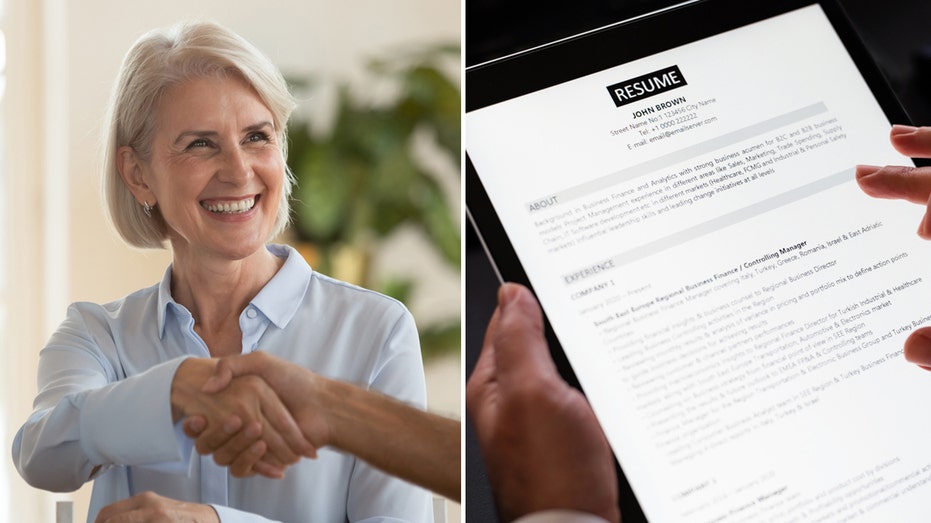Forty may be the new 50, but how can employees in their 40s best highlight their skill sets to shine in today’s competitive job market and land a new position?
Whether it’s adding tech-savvy skills to a resume, boosting SEO search terms, or incorporating more social media in your job search, there’s much to know about the career landscape.
FOX Business reached out to job experts who provided tips on how to get an edge if you're over 40 and looking for a new role in 2024.
Reboot your resume
Ageism is real, but it does not have to get in the way, according to experts.
It's all in how you present yourself, said Stacie Haller, a Boston-based chief career adviser with Resumebuilder.com.

Employees in their 40s often bring solid accomplishments and important experience to the table. But how to best highlight those areas in a job search? Experts share smart insights and tips. (iStock / iStock)
"Your resume must reflect what it should look like in today's world — and experience of over 20 years should not be listed with dates," she said.
Haller instead proposed creating something like an "Earlier Career" section, if it is helpful when applying to a particular position.
Additionally, she said that easy fixes such as not using an AOL email address and removing your street address and picture can eliminate obvious ageism tip-offs that have nothing to do with your ability to do a terrific job but can present you as "an old person."
Tailor your cover letter
Cover letters should be targeted and well-prepared, advised Haller.
"It should generally contain three simple paragraphs," she said.

"Your resume must reflect what it should look like in today's world — and experience of over 20 years should not be listed with dates," said one expert. (iStock / iStock)
"The first one is what you are applying to and why; the middle is highlighting a few of your specific experiences and successes that match the job description; and the third is thanking [a hiring manager] for their time and consideration and looking forward to next steps."
Research your prospects
"Doing your homework is key, as is individualizing your approach," Haller told FOX Business.
She added, "You should not be sending the same resume and cover letter to every job you apply for — they must be customized."
To that end, Haller said the individual job posting has all the details you need to know so that you can highlight certain areas on your resume and in your cover letter.
Add keywords as well. If the resume and other materials are being scanned, any keywords will pop up in a company’s automated applicant tracking system.
Be sure to network
During the job hunt, prioritize networking by connecting with former colleagues and friends to let them know you are open to new opportunities, recommended Doug Walker, manager of HR Services with Insperity in San Diego.
"Additionally, applicants over 40 should actively participate in professional organizations to stay updated on industry changes and ensure they hear about upcoming roles first."
Plus, those in their 40s and above have the leg up when it comes to networking, he indicated.

Attending networking events is a smart idea, say experts. Also, "an applicant over 40 is likelier to have connections who have risen into more senior roles." (iStock / iStock)
"They have already established a network of former colleagues and industry professionals with whom they have a rapport," said Walker.
"These relationships have been fostered over decades and can lead to some of the most helpful referrals, especially because an applicant over 40 is likelier to have connections who have risen into more senior roles."
Plan for an interview
If you’ve secured an interview, there are specific steps you can take to create better footing.
Refrain from dominating the discussion
During the interview, listen closely to the hiring manager or talent executive — and be prepared to ask your interviewer thought-provoking questions.
"This will show your aptitude for understanding the organization and identifying areas where you may help with any existing challenges," noted Walker.
Key point: Do not over-talk during your interview.
"Try to limit your talking to 40% and get the interviewer talking at least 60%," said Walker. "Interviewers will think you are a good listener who is very interested in the role. Ask open-ended questions and listen actively to accomplish that 40/60 ratio."
Highlight your skills and experience
Although you have talents, educational credentials, and demonstrated performance — there could still be bias.
"Age is a protected group; however, people have unconscious biases," Walker said.

Raising awareness of one’s age with phrases such as, "I've amassed a wealth of knowledge" — or using outdated business terms can suggest to an employer that the candidate has not changed with the times. (iStock / iStock)
"If a candidate’s first interaction with the organization is through their cover letter and resume, it is suggested a person not promote age."
For example, raising awareness of one’s age with phrases such as, "I have amassed a wealth of knowledge" — or using outdated business terms can suggest to the employer that the candidate has not changed with the times, even if that's not true, he said.
Showcase your updated talents
Highlight your measurable accomplishments and tailor your message about why you’re a great fit for the job at hand.
"Candidates should also include any training or certifications for new business challenges like AI to let the employer know they're in tune with current trends," Walker said.
Portray professionalism
"When interviewing, the recommendations are the same for any age," emphasized Walker.
"Research the company’s culture, dress to whatever standard is considered ‘professional’ by that industry, and let your personality shine," he also said.
"Though ‘business formal’ was once expected for interviews, the in-person workplace is more casual than ever before, so business casual interview attire may be appropriate. Whatever the role, dress the part."
Jason McConahy, a part-time Lyft driver in Las Vegas, sometimes drives as few as 10 hours a month. But the social benefits of the gig make his time on the road worthwhile.
In 2001, McConahy suffered a serious back injury that forced him to spend most of his time at home. He tried a few jobs, but he said working proved unsustainable. In 2016, when he and his wife felt their eldest child was old enough to babysit their youngest for short periods, McConahy began actively exploring outlets for social interaction.
It was during this search that he found ride-hailing. He said most customers prefer a "quiet ride," but occasionally, one will be up for a chat.
"Regardless of the type of passengers, it's human interaction," he told Business Insider, adding, "Driving for Lyft provides me with much-needed and appreciated social interactions outside my home."
McConahy is among many ride-hailing drivers who aren't just working for the supplemental income. For some, the social interactions with riders are just a perk of the gig, but for others, they've become more important than that.
To be sure, drivers don't always have positive interactions with customers. Several Uber and Lyft drivers have told Business Insider they've faced everything from rude comments to harassment while working — women drivers can face their own challenges. And when it comes to making money, many drivers have told BI that ride-hailing is less profitable than it used to be.
But as the US faces an "epidemic of loneliness," one that could cost the economy hundreds of billions of dollars a year, ride-hailing has provided a social outlet for some people.
Business Insider asked six Uber and Lyft drivers why they value the social interactions that can come with ride-hailing. BI has verified their earnings, which reflect how much they earned after the platforms took their cut — and before driving expenses.
Driving can help people transition into retirement
Many Americans have turned to ride-hailing in retirement to pad their savings — and reclaim some of the social interactions their jobs used to provide.
Mark McCann, a Dallas Lyft driver in his 60s, began driving part-time in 2021 after retiring from his sales career. He said his previous job required him to be constantly around people, so retirement proved to be a difficult transition.
While he primarily drives to supplement his income and tax benefits, he said he also enjoys engaging with riders.
"Ride-hailing enabled me to meet interesting people from all around the country and world," he said.
Larry, an Atlanta Uber driver in his mid-50s, began driving part-time when he retired from his retail job in 2019.
While he drives in part to boost his income — he earned roughly $12,000 before driving expenses in 2022 — he said the social benefits are 80% of the reason he drives.
"This allows me to get out and meet and mingle with people, which I truly do enjoy," said Larry, whose last name is known to BI but is being withheld due to fear of professional repercussions.
Chatting with riders can help drivers avoid burnout
Even when making money is one's predominant reason for driving, the social benefits can still provide some value, drivers told BI.
Take Rich, an Arizona Uber driver in his 70s who started driving largely out of boredom. Even though he considers himself to be retired, he told BI he typically drives between 40 and 55 hours a week when he's not traveling.
Rich, who asked to use a pseudonym and spoke on condition of anonymity for fear of professional repercussions, said interacting with drivers is not only something he enjoys — it's key to getting through long shifts and boosting his income. He made over $80,000 in 2022 before driving expenses.
"You have to like to drive," he said. "You have to like to meet people and to be able to carry an intelligent conversation. Otherwise, you're going to burn out early."
Chatting with customers has a similar value for Dean Ceran, a Virginia Uber driver in his 60s who works between 50 and 60 hours a week. He earned over $59,000 in 2022.
"The pros are the money I earn and the people I meet along the way," he said, adding, "I love the interaction with the wide variety of people that request Uber rides."
While conversations during rides offer benefits for some drivers, they're not the only ones who get something positive from them. Riders, oftentimes, enjoy having someone to talk to as well, drivers told BI.
"It's like therapy," said a Boston Uber driver in his 50s who asked to remain anonymous for fear of professional repercussions. "It is great if someone wants to commiserate or bond or just vent. I enjoy the variety of conversations."

